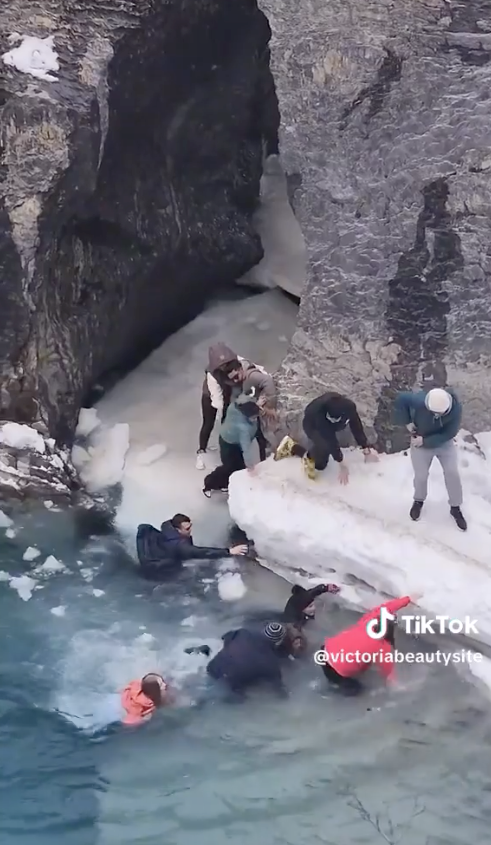FIELD, B.C. – Parks Canada has issued a safety warning after six tourists crashed through ice into Kicking Horse River at Natural Bridge in Yoho National Park – a stark reminder of the dangers of fast-flowing rivers in the mountains.
A video, posted on various local social media sites in the Bow Valley last week, shows others in the group exploring the area beneath the Natural Bridge helping the six out of the frigid water before they were swept away.
“I don’t think anybody was injured or stranded, but it was an extremely close call. They were lucky. Frequently, people who fall in the river are not as lucky,” said Brian Webster, manager of visitor safety for Banff, Yoho and Kootenay national parks.
“It illustrates the hazards associated with being close to a river edge and how quickly things can go wrong if you're unlucky or if you happen to slip or fall. It really emphasizes the hazards associated with moving water, particularly in the winter.”
The force of the Kicking Horse River cascades under a naturally formed limestone bridge, known as the Natural Bridge, along Emerald Lake Road west of Field. It is a prominent tourist hot spot in Yoho National Park.
@victoriabeautysite Witnessed a scary moment today at Yoho National Park in Alberta. People fell from an ice sheet into the lake near natural bridge. Please be cautious as the weather is changing and the ice is melting. Safety first, always! #yohonationalpark #albertanews #alberta #narcitycanada #canadatravel #drivebc #bcdrive #highway1 #albertatourism #nationalpark #transcanadahighway #traveladvisory #ExploreCanada #DiscoverCanada #MountainLife #Hiking #NaturePhotography #WildernessCulture #ExploreAlberta #BeautifulDestinations #Wanderlust #OutdoorAdventure #IceMelt #ClimateChange #EnvironmentalAwareness #edmonton #banff #calgary #EmergencyPreparedness #banffnationalpark ♬ original sound - Harsha Kalra
A short trail leading from the day-use area crosses a bridge above the Kicking Horse River for a view of the Natural Bridge, however, the group climbed a fence and barriers to reach the river’s edge to explore the natural rock formation.
Webster said hazards associated with swift-moving rivers, both in summer and winter, are often underestimated by visitors.
“River edges are usually wet and slippery, and in winter the edge of the rivers may not be obvious due to snow, or as was the case in this video, by shelf ice along the edge of the river,” he said, noting visitors should keep a healthy distance away from fast-moving water.
“If someone falls into the river, it will be very cold and it can often be difficult to get out. You can go from being 100 per cent in control to being 100 percent out of control very quickly when you end up in the water.”
Parks Canada’s rescue team is called yearly to pluck people from various rivers in the park, and while many are successful rescues, sometimes the results of falling in are deadly.
Since 2019, the visitor safety team has responded to five water-related fatalities, including at Lake Minnewanka in September 2019; North Saskatchewan River in July 2020; Marble Canyon in August 2020; the Bow River near Banff in April 2021 and Lake Magog near Assiniboine in July 2022.
In the 2020 Marble Canyon incident, a 34-year-old Calgary woman died after being swept over a waterfall at Tokumm Creek and through the canyon in Kootenay National Park on Aug. 16.
A man who tried to save her also went over the waterfall and into the 12-metre deep slot canyon – which has a series of cascades beyond the first big drop waterfall – and remarkably survived.
In this case, the woman had climbed or scooted around the end of the fence at the top of the canyon to get her photo taken when she slipped and fell about 18 metres upstream of the top waterfall.
In July 2020, a 23-year-old man Calgary man slipped and fell along Glacier Lake Trail into the fast-flowing North Saskatchewan River in Banff National Park while getting his photograph taken.
After an extensive search that was eventually scaled back, his body was found on Sept. 20 near a remote island west of Abraham Lake, about 30 kilometres from where he fell in.
Another high profile rescue occurred in July 2016, as tragedy struck a Calgary family picnicking at Takakkaw Falls in Yoho National Park when an 11-year-old boy was swept away in the raging waters of the Yoho River.
The boy’s body was found days later about 13 km away, in the Kicking Horse River.
Webster said fast-flowing rivers, which are an attraction to many, are probably the “biggest hazard in the park for the bulk of the visitors.”
“The hazards are not often as obvious as other hazards, for example, a cliff. If people are approaching the edge of a steep cliff, the hazard is very obvious. They’ll take appropriate precautions and avoid it, or maybe get down on their hands and knees and approach it carefully,” he said.
“The risks associated with getting close to a river are often underestimated. We have regular occurrences where people are falling into the water and similar to this case at the Natural Bridge day-use area.”
In the case of the Natural Bridge incident, as well as in various other locations throughout the mountain parks, fences and guardrails are in place for visitor safety.
“Anybody deciding to travel off trail, they are responsible for their own safety,” said Webster.
“They should be aware of the hazards and they should be taking the appropriate precautions.”




